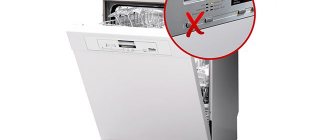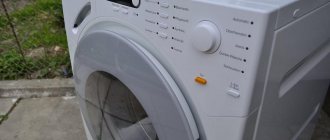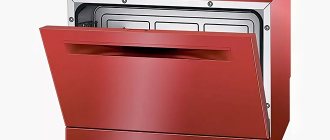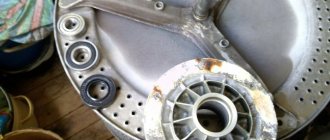Key situations of occurrence of defects in the operation of a dishwasher
Despite the wide range of possible problems, there is a certain range of the most common problems. The ability to diagnose the cause of a malfunction can give the owner the right to choose a method for eliminating them. In some situations, the owner of the equipment can do it on his own and not pay for the help of a specialist.
- The device does not turn on.
- It is necessary to check the serviceability and voltage in the electrical network of the room where the device is installed. Perhaps the problem is that the entire room is de-energized.
- You should check the serviceability of the power cord. Bends, bare spots, creases, and so on can lead to incorrect supply of electric current to the device.
- The dishwasher safety device has tripped. In such a situation, it is enough to simply reboot it.
- Water appeared under the machine. As a rule, this fact does not indicate anything serious. Possible causes of its occurrence are resolved at the everyday level.
- The drain or discharge hose is damaged.
- The permissible water level has been exceeded.
- The permissible level of detergents has been exceeded.
- During washing, a surfactant or SMS is used that is not intended for the dishwasher.
- The device is installed on an inclined surface.
- Unwashed dishes. Most likely, the equipment's sprinklers are clogged, so they need to be cleaned.
- There is no water heating. The most common reason is a breakdown of the heating element, which burns out over time. The second reason is a malfunction of the control unit.
- The device is too loud.
- The machine is not installed on an uneven surface and will need to be reinstalled.
- The pump is faulty and needs to be replaced by a technician.
The appearance of water under the machine is not a sign of serious damage.
We also recommend reading about the cause of error e24 in the dishwasher.
What repairs will be needed if the dishwasher stops and turns off?
If there is a malfunction, and the problem is not a blockage or missing power supply, the technician will replace or repair the heating element, sensor, thermostat or other faulty component of the dishwasher. The control unit may need to be reflashed - often the reason is its errors and failures.
There are a great many breakdowns. Only about 1/3 of the faults are identified by the PMM self-diagnosis systems, and the rest remains on the conscience of the machine repairman. Today we will discuss the situation when the dishwasher turns off during operation. This breakdown is not so unusual, however, it can create a lot of problems for the user. Let's identify the main causes of this breakdown and see how they can be eliminated.
How to Reset a Dishwasher
A couple of decades ago, dishwashers were the privilege of only wealthy citizens of our country, as well as movie characters. Very little time passed, and this unit appeared in the homes of ordinary people.
Equipment manufacturers were able to fine-tune the technology for manufacturing dishwashers so that they are not expensive and allow housewives to save time, energy and labor. Like any other equipment, as its service life increases, dishwashers begin to malfunction and accumulate errors, such as E03, E4, E22, E24, E09 and many others. Many of the software errors block the operation of the equipment and prevent it from being used for its intended purpose. At such a moment, housewives and owners are faced with the question of how to reload the dishwasher quickly and without consequences.
Like any other appliance, as its service life increases, dishwashers begin to malfunction and accumulate errors.
Opinion of housewives closing the machine
To figure out which of the two militant camps is closer to the truth, you need to familiarize yourself with the arguments of both. Try to figure them out and then draw conclusions. This is what proponents of locking the car after washing say.
- Firstly, after purchasing and installing the PM, water is found inside. In the store it is kept closed, but after opening the door of the house there is no trace of mold or unpleasant odors. So, there is nothing to worry about.
- When washing, various household products, usually powders, are added to the unit. If you rarely use the machine, chemical residues will invariably be inside, but nothing will happen to them in the remaining water, and they will be suitable for further use. And if you open the door, everything will just dry to the walls.
- In small-sized apartments, kitchens are not very spacious anyway, and if you open the dishwasher, you won’t be able to turn around at all. Surely, the manufacturers made sure that such a need did not arise.
- On some models, the backlight turns on when the door is opened. As long as the door is open, the light is on.
The above opinions can well be called rational. But let's not rush to conclusions. Now let's move on to the arguments given by housewives who prefer to ventilate the dishwasher.
Like Dislike Alex_Nevada June 26, 2021
Many people believe that a wash cycle ending halfway is because the timer is faulty. However, there are a number of reasons why the dishwasher may turn off during operation:
- Assembly from low-quality spare parts. Inexpensive Chinese models break down first.
- Before loading dishes, you do not rinse off food residues. This leads to filter clogging. The dishwasher will not wash dishes that are too dirty.
- The socket is broken.
- Incorrect machine connection.
- Poor quality detergent that does not wash dishes.
- The door is not tightly closed.
- Place plates in the top row and place pots and pans in the bottom row. Cups and wine glasses must be placed upside down.
Sometimes the reason the dishwasher turns off may be a simple failure to follow the operating instructions. However, there are also more serious problems.
Modern dishwashers are equipped with software, so if a problem occurs, the machine may turn off and display an error code. Sometimes neon lights light up on it. The code consists of alphabetic and numeric characters. For example, F10 or E2. You need to write them down and look at the instructions; code designations are sometimes written there. If not, you should inform a specialist about this.
Dishwasher Error Codes
The dishwasher may turn off for the following reasons:
- Wrong washing mode set.
- There is no power supply. You need to check the switchboard, perhaps the fuse has blown or the circuit breaker has switched off.
- The fuse in the plug has blown. It is necessary to replace it and check the entire safety device.
- The main pump is clogged. This problem is difficult to debug with your own hands, but you can check the exhaust port. You need to lift the filter and inspect for blockages.
- Problems with the thermostat.
- The heating element has failed.
- The programmer is broken.
- Water does not flow into the working chamber. This may be due to the tap being closed.
Often the float switch breaks. It is a mechanism in the form of a plastic float located in the floor of the machine. When the chamber is full, it floats up. This switch can block the operation of the dishwasher if its valves are faulty.
The inlet channel located at the bottom of the device may have failed. It may become clogged and block the passage of water.
The pressure switch may break. It needs to be disconnected from the terminals and blown into the pipe to which the plastic tube is adjacent.
If a shutdown occurs when you first start the machine, then the wires in the plug itself may be incorrectly connected.
Failures in the electromagnetic control coil are also common. The breakdown is very serious and will require the intervention of specialists.
If the water is too hard and food residues often remain on the dishes, then the sprayer may fail.
A burnt out motor or problems with a pump require calling in a professional.
During the drying stage, the electric heating element may burn out or the fan may malfunction, and the machine will turn off spontaneously.
How to troubleshoot your dishwasher
If the reason the dishwasher turns off is a clogged filter located at the bottom of the dishwasher chamber, then it must be removed, washed and put back. A common problem is also clogged injectors. You need to take a toothpick and clean the holes.
Before starting repair work, do not forget that you need to turn off the machine from the network (remove the plug from the socket, turn off the fuse) and close the water tap.
Some problems can be resolved on your own, while others require experienced intervention. If you do not understand electrical engineering, it is better to entrust dishwasher repair to specialists.
"Weak points" of famous brands
The most common malfunctions of the device can be caused by the following factors:
- low-quality parts on cheap models of cars;
- poor cleaning of dishes before loading often causes the dishwasher to become clogged (the filters become dirty);
- use of third-party or low-quality detergents (poor dishwashing);
- a poorly secured door can cause water leakage (manufacturing defects cannot be ruled out);
- improper loading of dishes (poor washing).
In addition, various components of the PMM may fail: temperature sensor, circulation pump, various valves and other components of the device.
But there are also frequent malfunctions that are typical for certain brands of dishwashers. This information is taken from statistical data from service centers for repairing household appliances. Below we will look at typical faults for various brands of dishwashers.
Hansa
The main malfunction of the Hansa PMM, according to statistics from service centers, is the failure of the water level sensor. Often the electrical part of the pressure switch burns out, so it needs to be replaced with a new one.
But before you start repairing Hansa dishwashers, you need to determine if the sensor is broken by the following symptoms:
- The dishwasher constantly fills and drains water;
- Hans's machine takes in less water than required;
- the unit takes in more fluid than normal;
- The PMM stops the execution of the program and stands without pumping out water.
If at least one of the symptoms occurs, then disassembling the device will be required to remove the sensor. But it is better to entrust this procedure for repairing or replacing the sensor to a specialist: he knows the entire algorithm for checking the pressure switch for serviceability.
AEG
According to experts who repair AEG dishwashers, units from this company often have malfunctions due to failure of the drain pump. You can find out that it was the pump that caused the breakdown by looking at some signs:
- the pump motor makes sounds, but water is not pumped out of the unit;
- at the time when, according to the program, the device should drain water, it stops;
- The dishwasher freezes with the error “I 20” when the washing program starts.
If these signs are present in the AEG PMM, then you will need to check the pump motor with a multimeter.
You need to do the following:
- first of all, for safety reasons, you need to turn off the power to the device and turn off the water supply;
- remove the inlet and drain hose;
- lay a rag on the floor and pull the car onto it;
- Place the unit on its back side and remove the pan.
After removing the pan, it is not difficult to find the pump: pipes and hoses are connected to it. Remove all wires from the pump contacts and touch them with the multimeter probes. If measurements show a break or short circuit in the winding, the pump will have to be replaced.
NEFF
Frequent activation of the leakage protection system is the main disease of the NEFF PMM. But there is nothing serious about this breakdown, and there is no need to call a repairman. How are NEFF dishwashers repaired in this case?
First you need to understand how protection works. The washing chamber has a large float located at its bottom. When liquid enters the pan, it raises the float, the sensor is triggered, after which the operation of the unit stops. This is how good protection works.
But when dirt or food debris gets under the float mechanism, the float can rise and turn on the protection. Repairing NEFF dishwashers in this situation is very simple:
- using the on/off button, turn off the unit;
- after opening the chamber door, grab the float cover - you should raise and lower it several times, and all dirt and food debris can be removed with a cotton swab;
- You can turn on the unit and check the operation.
Whirlpool
Internal valve failure is the most common failure in Whirlpool machines. Before you begin repairing Whirlpool dishwashers, you need to make sure what exactly has failed in this valve (mechanical or electrical).
If the electrical part is faulty, the valve will have to be replaced. If the reason is mechanical, then you can fix it yourself. To repair a dishwasher, you will need:
- disconnect the power supply from the unit;
- remove the front panel, which is located under the door;
- on the left, in the front of the device, you can see the valve itself, to which the hose is connected;
- Connect the ohmmeter probes to the contacts of the part, having first disconnected the wires.
Before starting the measurement, you need to set the resistance value to a minimum. If during measurement the tester shows from 500 to 1500 Ohms, this will mean that the electric coil is working.
If the values are too low or too high, the coil has become unusable. If the electrics are working properly, the malfunction is caused by the fact that the valve may become clogged with limescale. To do this, the body of the Whirlpool machine is unscrewed and the mechanism is cleaned.
Ariston
Ariston is a fairly well-known and popular brand. But despite this, PMM from this manufacturer also has typical breakdowns.
If we exclude clogged filters and mechanisms in the dishwasher, then most often repairs of Ariston or Siemens dishwashers are carried out due to the fact that the heating element burns out or the terminal block burns out.
It burns out for the reason that during the operation of the water heating program, one or two circuits may turn on. And the entire load falls on this part.
It is not possible to change it, and you have to buy a new heater, even if the old one is working. This part must have the same markings as on the original spare part.
Repairing Ariston dishwashers to replace the heater is not difficult and can be done by yourself. But after installing the element, you will first need to run the quick wash program without closing the body of the Hotpoint-Ariston unit.
This is done in order to check the connections for water leakage into the dishwasher, since the element is a flow-through type. If necessary, tighten the clamps further.
In case of other malfunctions in the components of the Hotpoint-Ariston dishwasher, repairs must be carried out by a specialist.
Smeg
Frequent reasons for which technical repair of Smeg dishwashers are required may be a failed heating element, temperature sensor, drying fan or control module.
How to disassemble a dishwasher and change dishwasher heaters was discussed above. Well, what should you do if your PMM has a turbo-drying function, but the dishes remain wet? This fact may mean that the fan blowing hot air has failed.
Repair and replacement of the fan, as well as the temperature sensor of the dishwasher, must be carried out by a technician from the service center. Self-repair of dishwashers from Smeg and other brands (including repair of washing units) if the control module fails is impossible.
This should be done by a qualified technician, since only he can determine the malfunction of the module and, if necessary, repair or reflash it. This rule of hiring a specialist should also be followed when professional dishwasher repairs are required.
Candy
Most often, Candy dishwasher repairs occur due to improper handling of the equipment (regular filter cleaning is required when servicing the dishwasher). When the drain system is clogged, the pump operates with a suspended load and often fails.
Users also complain about leakage from under the door during operation of the Candy unit. According to reviews, it happens after one year of using the machine. The trouble is eliminated by replacing the sealing element.
Zanussi
Zanussi dishwasher repairs most often occur due to liquid leaks. Car models in which the Aquastop protection system is installed show an error code i30 on the display. But it happens that there are no errors, but water still appears from under the unit. The reason may be:
- the appearance of a crack in the tank;
- drainage hose leaking;
- loosening of connecting clamps;
- The supply valve may become stuck open.
To replace the tank, you will have to contact a specialist who specializes in repairing dishwashers, since the unit will have to be completely disassembled.
Repairing dishwashers with your own hands in such cases causes great difficulties. This breakdown is also common when repairing Indesit dishwashers.
You can replace clamps and hoses yourself. To change the hose you need:
- de-energize the device;
- turn off the water;
- disconnect the drainage hose from the sewer and the machine;
- do everything in reverse order with the new hose.
There is an inlet valve where the inlet hose enters the washer. If, when checking with an ohmmeter, the tester shows that there is no resistance, the part will need to be replaced with a new one.
It is worth noting that the repair of professional dishwashers Zanussi, Ariston, Kandy and others should only be carried out with the involvement of specialists from service centers.
You can get rid of most of the above breakdowns, which are typical for PMMs from different manufacturers, with your own hands, without the help of a specialist. But the main thing is not to overestimate your capabilities and take on the repairs that you are able to make.
Source: https://washergid.com/neispravnosti-posudomoechnyh-mashin-i-ih-ustranenie
Invalid program
Some washing machines have a special spin-free mode. Applicable when selecting the following programs: wool, silk, down jacket or gentle wash. These modes may vary depending on the model. Therefore, it is necessary to study the instructions for your sample, in particular, the description of the programs. In advanced brands, the drum rotation speed can be independently adjusted. And for example, turn off push-ups, as in the photo below.
Control Panel
This situation is not related to the breakdown of your assistant, but is a consequence of haste or inattention.
The dishwasher knocks out the machine, plugs, ouzo
In the twenty-first century, household appliances have taken over much of the routine housework. Modern dishwashers have freed housewives from having to wash plates, mugs and pots several times a day.
Household appliances are constantly being improved: they are supplemented with new functions, equipped with more advanced programs, and become more and more reliable and economical. The latest models of dishwashers require about fifteen liters of water for the entire wash cycle.
One of the common breakdowns is that the dishwasher knocks out the plugs and triggers the ouzo (residual current device).
Why does my dishwasher pop?
There are many reasons when the ouzo protection is triggered or the dishwasher knocks out plugs in the apartment.
If such a situation occurs, you should first make sure that the culprit is the dishwasher, and not some other household appliance, and also check that the plugs correspond to the existing power grid loads.
If there are many electricity consumers in the apartment, then connecting another device can create a total load that exceeds the calculated load for existing protection devices (uzo) or plugs.
You can understand their work only if you have accurate diagnostic equipment and extensive experience in operating a specific model of household appliances. In addition, with unqualified intervention and neglect of safety rules, you can get an electric shock.
Independent repair attempts when the dishwasher knocks out plugs usually end either in vain or cause new breakdowns.
Important! If the automatic protection is triggered or the plugs are knocked out, the dishwasher should be immediately de-energized (unplugged from the outlet). When the protection triggers, it means that there is a short circuit somewhere inside the dishwasher.
The cause may be frayed wires that have gotten under moving mechanisms or a faulty heater (heater). If the hardness of your tap water is high in your area, this may significantly reduce the life of your dishwasher.
When the protection trips, it means that there is a short circuit somewhere inside the dishwasher. The cause may be frayed wires that have gotten under moving mechanisms or a faulty heater (heater). If the hardness of your tap water is high in your area, this can significantly shorten the life of your dishwasher.
And at the moment the heater is turned on, a short circuit occurs through the water to the body of the dishwasher, which, in the absence of proper grounding, leads to knocking out the plugs or tripping the machine.
The real scourge of household appliances is sudden voltage surges in the electrical network, leading to burnout of various electronic circuits. First of all, the power supply and built-in surge protector suffer.
All of these faults can be fixed in a few hours right at home, without the need to transport the dishwasher to a workshop.
Modern equipment and reliable components allow you to repair your dishwasher efficiently and quickly.
After completion of the repair, a thorough testing of all modes of operation of the dishwasher is carried out, paying special attention to whether it knocks out plugs and whether the alarm is triggered.
All work performed is guaranteed and a warranty card is issued.
To replace failed parts and components of a dishwasher, original spare parts from the dishwasher manufacturer are usually used. This is the key to complete restoration and long-term stable operation of household appliances.
As a gift to our clients, we sell components and consumables without a trade markup (ten to fifteen percent below the market price).
Call a technician if the dishwasher breaks the plugs
To call a specialist, you just need to call the phone number listed on the website. You can also fill out an online application on the right side of the site page. The specialist will call you back soon and clarify all the details.
The dishwasher is knocking out the plugs, what should I do? call a specialist to your home in Moscow
8(495)5075840 and
BACK
What to do if the dishwasher stops and turns off?
If your dishwasher stops prematurely, first make sure it is plugged in and has power. This can be understood by the backlight. If it is not there, try turning on the machine again. Nothing happens? It is quite possible that the cable is damaged or there is no electricity.
Did your BOSCH dishwasher work for some time, then switched off, but there was still water in the chamber? Unplug the power cord, drain the water manually, and after a while the door will unlock.
Be sure to unplug the dishwasher and remove excess water and dishes from the chamber. After this, you can call a specialist.
Main device of the dishwasher
If you want to know how an Indesit, Bosch, Electrolux or dishwasher from any other brand works, be sure to read the material to the end. Let's start with the most important thing - the heart of the device. It is a powerful motor, sometimes called a circulation pump.
. It circulates water with detergent or rinse aid, taking it from the working chamber and returning it through the rocker arms. As for the rocker arms, they serve as rotating spray nozzles.
The largest element in a dishwasher is the working chamber. It is in it that the rocker arms are located, playing the role of washing elements. There are also baskets where dishes are placed. Baskets can be adjusted in height, and some manufacturers provide them with a transformable design, which makes it easier to store kitchen utensils of non-standard sizes.
- Filter – provides filtration and removal of solid contaminants (food residues);
- Drain pump (also known as drain pump) – removes dirty water outside the dishwasher;
- Drain hose - its purpose is clear without any comment;
- Aquastop - it is not present in all dishwashers, but it allows you to protect against leaks. The executive element of this unit is a solenoid valve located at the very end of the inlet hose.
Also in the device of any dishwasher there is the following combination:
- Inlet hose - it is connected to the water supply system, through which cold water flows into the device (or hot water, if someone connected the equipment to a hot water supply pipe);
- Solenoid valve - participates in filling water, shutting off or opening its supply;
- Water heater - classic or instantaneous. The latter helps reduce cycle times by heating water instantly rather than gradually.
Please note that in front of the inlet hose there is a simple coarse filter in the form of a metal mesh. It plays an important role in the design of a household dishwasher, filtering out large contaminants that can enter the dishwasher from the water pipe. As we can see, the design of dishwashers is extremely complicated.
And all this despite the fact that we have not yet touched on a number of important organs, nodes and systems. The ion exchanger is a very important part responsible for softening water. The thing is that salts dissolved in hard water interfere with normal washing. An exchanger operating on the basis of a special ion exchange resin allows you to replace magnesium and calcium ions with sodium ions, resulting in softer water
As we can see, the design of dishwashers is extremely complicated. And all this despite the fact that we have not yet touched on a number of important organs, nodes and systems. Ion exchanger is a very important part responsible for water softening
. The thing is that salts dissolved in hard water interfere with normal washing. The exchanger, which operates on the basis of a special ion exchange resin, allows you to replace magnesium and calcium ions with sodium ions, resulting in softer water.
A container is installed in conjunction with the ion exchanger, into which salt or substances replacing salt are poured - they help restore the amount of sodium ions in the ion exchange resin. Salt is taken from here automatically, its amount depends on the settings in the dishwasher. The container holds approximately 1 kg of special salt for dishwashers.
In addition to all this, dishwashers contain pressure switches (water level sensors), thermostats (determine the temperature of the washing mixture), and various touch sensors (in machines with automatic programs). Water inlets for collecting water are also installed here, and there are numerous connecting hoses and clamps. The whole thing is wrapped in a body with effective noise insulation.
We forgot to mention the most important detail in the internal structure of any dishwasher - this is the control board, which is the “brain” for the entire filling. It is from this that the wires go to the sensors and various electrical modules. A control module works in conjunction with the board, on which knobs, buttons, indicators and other elements are located
A control module works in conjunction with the board, on which knobs, buttons, indicators and other elements are located.
Older dishwashers had mechanical control modules. They are not used in modern technology - their device is based on electronics.
As for detergents and rinse aids, they are loaded into special dispensers - most often they are located in the loading doors. Tablet preparations of the “All in one” format are also placed here, containing all the necessary chemicals.
Main malfunctions of dishwashers
Home » Household appliances » Appliance repair » Basic dishwasher malfunctions
A dishwasher can make life easier for many women. Sometimes you may encounter problems with your dishwasher not turning on, not draining, or leaking. These reasons are considered the most common. You don’t need to rush to call a technician, since you can fix dishwasher malfunctions yourself.
In this article you will learn how to troubleshoot possible dishwasher problems. We have collected detailed information that contains video tutorials. After reading our article, you will learn how to repair a dishwasher.
Causes of dishwasher malfunctions
If your equipment has been in service for 5 years, then the cause of the malfunction may be simple wear of parts. If you recently purchased a dishwasher, then the following factors may cause the breakdown:
- Poor quality components. This can usually occur with cheap models.
- Before loading dishes, you do not rinse off food residue. If the dishes are very dirty, then food may clog the filters and the dishwasher will not flush water.
- The socket may have failed.
- You use bad detergents that don't wash dishes.
- If your dishwasher is leaking, then you may not have closed the door properly. If the door does not hold, then the manufacturer did not secure it properly.
- Dishwasher problems can also be caused by improper loading of dishes. Up you need to fill with plates and cups. Large utensils must be placed downwards.
If none of these reasons apply to you, then it may be due to low-quality parts that have failed. The hood may also need to be repaired for similar reasons.
Troubleshooting basic dishwasher problems
The washing process does not start
Here's the situation: you started the dishwasher and all its lights came on. If you hear water collecting in the chamber, but the washing process does not occur, then the cause of this breakdown may be:
- Clogged filters. They are located at the bottom of the chamber. To clean it, you will need a sufficient filter and rinse it under water pressure.
- Clogged injectors. As a result, the mechanism will not be able to spray water. In this case, you can punch holes using toothpicks. Clogged nozzles in your dishwasher can also cause pots to fail to clean. If the mechanism does not spin, then you can check the circulation pump.
- The circulation pump may have failed. This pump is responsible for supplying water to the nozzles. This reason is considered quite serious, since as a result of a breakdown you need to replace this pump. To get to it, you need to disassemble the case.
A possible cause of the malfunction may also be a breakdown of the motor winding. To make sure it works, you need to check this device using a multimeter.
The water is overflowing
If the water in the dishwasher overflows, then the water level sensor may be broken.
It is located at the bottom of your device. In order to get to it, you will need to turn the dishwasher over and replace this sensor.
Overheating or underheating of water
Sometimes you may encounter a situation where the dishwasher overheats or, on the contrary, does not heat the water. If you encounter this situation, then the temperature sensor may be broken.
Underheating of water in the dishwasher can occur for the following reasons:
When you repair a boiler, this element should also be checked first.
Dishwasher does not drain water
If after washing the dishes the water does not flow down the drain, then the pump may be broken. In the first case, you need to check the pump for debris. Most likely, the water is standing in the dishwasher due to contamination of the pump. If the pump is fine, then the hose or filter inside may be clogged.
There is another reason why the dishwasher does not drain the water completely. You may have pulled up the drain hose too much during installation.
The body is electrocuted
If your dishwasher is electrocuted, then the electric heating element is broken. In order to repair this element, you first need to open access to the heating element.
After this, it must be removed and visually inspected for damage. If they are detected, the heating element must be replaced. Usually this device fails due to poor water quality.
Doesn't pick up detergent
If you see that the dishwasher does not pick up detergent or powder, then the cause of the breakdown is dirty nozzles. The cause of the breakdown may also be a breakdown of the valve opening mechanism. As a result, the valve will not draw detergent. If the valve does not open the water intake well, then the tablet will not dissolve well.
Lack of power
If, when you turn on the device, the indicators do not light up or the equipment does not respond to pressing buttons, then the cause of the breakdown may be:
- Broken socket.
- Door latch is damaged.
- Broken network button.
- The power filter is broken.
In all cases, you need to use a multimeter. With its help, try to check each of these elements.
Presence of extraneous noise
If you hear extraneous noise, then the bearings may be damaged. Bearings can break due to water ingress. To fix the problem, you will need to replace not only the bearing, but also the seal on the dishwasher. Sometimes the cause of extraneous noise can be contamination of the pump.
Dishes won't dry
Many models have a dish drying function. This process occurs with the help of a fan installed inside. If your dishwasher is not drying your dishes, then the fan may be broken. It needs to be checked with a multimeter, and if it is broken then it should be replaced.
Water leak
Dishwasher failures are usually caused by water leaks. Today there are 4 main reasons for water leakage:
As you can see, the causes of dishwasher malfunctions are varied. You can solve most problems yourself.
We recommend to your attention: what to do if the refrigerator does not turn off.











